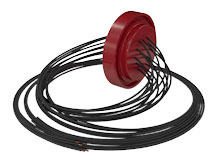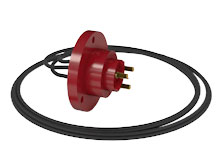Low Voltage Bushings
- Page 1 of 1

PFF
- for indoor service
- air to oil environment
- up to 2.5kV/45kV BIL
- up to 6000 amps
- 3.00” – 5.00” below flange diameter

PMT
- for indoor service
- air to oil environment
- up to 2.5kV/45kV BIL
- up to 3600 amps
- 2.14” – 4.00” below flange diameter

POFF
- for outdoor service
- air to oil environment
- up to 2.5kV/45kV BIL
- up to 6000 amps
- 3.00” – 5.00” below flange diameter

POMT
- for outdoor service
- air to oil environment
- up to 2.5kV/45kV BIL
- up to 3600 amps
- 2.14” – 4.00” below flange diameter
- Page 1 of 1
What are Low Voltage Bushings?
Low voltage bushings are designed to allow power or signals to pass through a conductive barrier, while maintaining electrical isolation and protecting the system from electrical breakdown. They are used in a variety of electrical equipment, including transformers, switchgear, and circuit breakers for low voltage applications under 15kV. Compared to high voltage bushings, LV bushings are designed to handle lower voltages and higher currents.
LV bushings are primarily used as connection points for the power cables that leave the transformer and feed the downstream demand (or system). They are also used to connect power between internal compartments within transformers and other devices. When installed in a transformer, LV bushings provide a seal from the inside of a transformer cabinet to the outside which prevents transformer oil or gas leakage.
LV bushings are typically made of high strength insulating materials such as epoxy or porcelain which house the conductor. Depending on the application, they may be designed with various features such as customized conductor terminations (stud, spade, or lug) or mounting hardware to simplify installation and connection to the external circuit.
Polycast manufactures epoxy LV bushings, which have many advantages over porcelain LV bushings. Epoxy bushings are stronger, lighter, more durable, easier to install, and more flexible than porcelain and other materials. Epoxy is the main choice for power utilities, industrial plants, and renewable energy companies, as well as railways, data centers, and the oil and gas industry. If you have ever encountered downtime brought on by the field failure of a porcelain bushing, employing epoxy bushings could have reduced the expensive cost of that downtime.
Our high standards guarantee great quality, dependability, and safety, in compliance with the relevant industry standards, including CSA, IEC, NEMA, and IEEE.
Low Voltage Bushing Manufacturer
Polycast is a trusted manufacturer of epoxy low voltage (LV) bushings, offering both standard and custom designs for transformers, switchgear, and other low-voltage electrical equipment. You can easily request a quote for any of the products listed above using the available options.
We also specialize in retrofit solutions for older or non-Polycast LV bushings to ensure compatibility and reliable performance. Whether you're upgrading existing systems or planning a new installation, Polycast is ready to support your needs. Contact our team to discuss your specific requirements. Our experienced engineers are here to provide personalized assistance and technical guidance.




